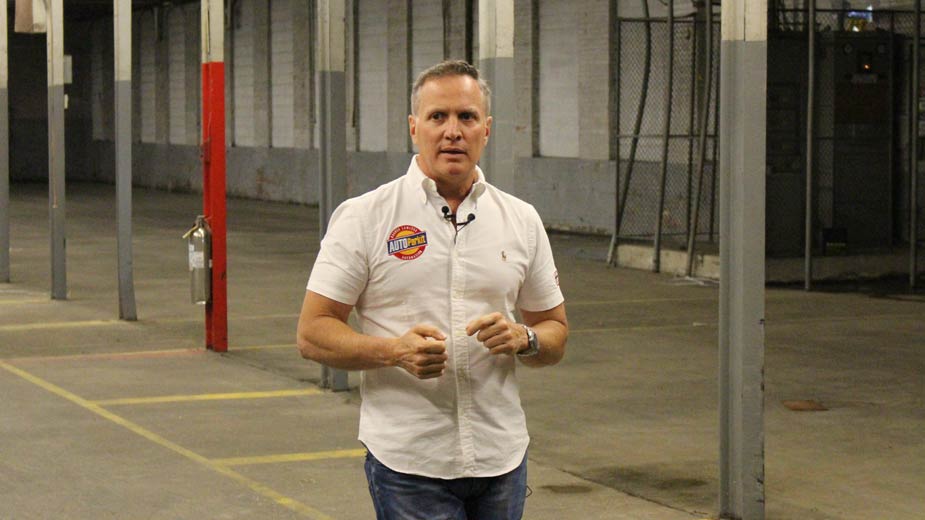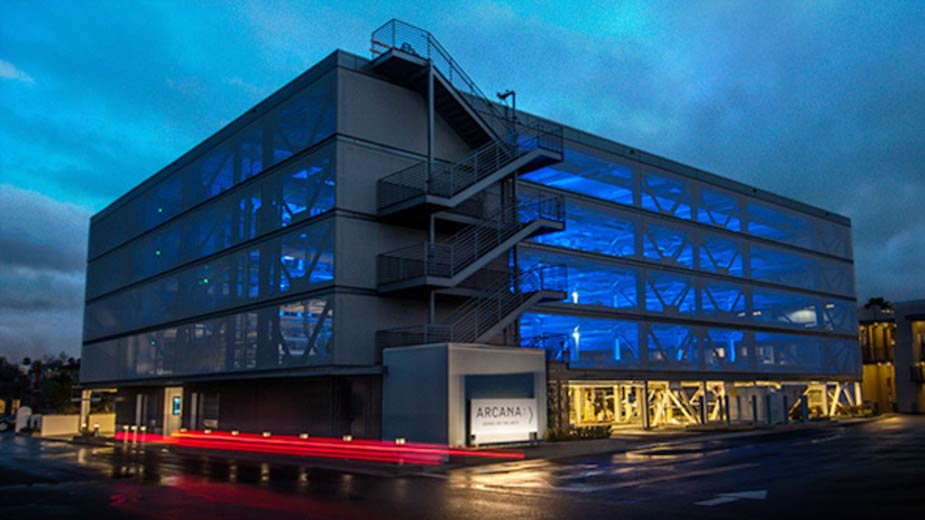Amid Challenges, AutoParkit Project Forges Ahead
WARREN, Ohio – Despite delays that have kept the AutoParkit project from advancing as quickly as expected, Christopher Alan said he remains committed to the city. And he expects to begin making payments on back taxes owed on properties he purchased out of bankruptcy about a year ago that were incurred by the previous owner.
Alan, a Warren native, is president and CEO of Dasher Lawless LLC in Van Nuys, Calif., which manufactures and builds the AutoParkit automated parking systems.
“If everything goes the way it should, in the next 24 months we should be well over 100 people,” if not closer to 125, Alan said. He pointed to a list of upcoming or current jobs, including a 510-stall system in Temecula, Calif., another in Detroit and a third in Los Angeles.
“All in, it’s a significant amount of work,” Alan said. “We’re hoping to manufacture as much of that product – at least half of that product – here in the factories, but we’ve got a lot of ramping up to do that.”
Roughly four years ago, Alan announced plans to base AutoParkit’s manufacturing operation in the former Packard Electric buildings on Warren’s Dana Street. Alan secured the properties, formerly owned by Maximus III Properties LLC through U.S. Bankruptcy Court last year.

Before then, because of the delays in acquiring the Packard properties, Alan in 2017 acquired the nearby former General Electric property.
“We never intended to buy this building. The building was purchased when we through the sale across the street was going to fall through, right before the bankruptcy, and we needed a place to go ahead and start making the components,” Alan said.
“The problem that we had at that point was we had new projects starting, and because of the delays we couldn’t make the product here,” he continued. “We ended up having to subcontract that out, and along with that subcontracting went the profit that would have been made from that, so the revenue that we would have made on the manufacturing side was given to subcontractors.”
In addition to the Detroit project and the two in California, Alan said he has four more projects set to begin next year.
Alan now has 32 employees working in Warren, roughly half of them in engineering and design positions, he reported. About six are on the floor doing manufacturing, another half-dozen are performing renovation and upkeep on the Packard and G.E. properties, and the remainder are performing administrative tasks.
Annual payroll already is in excess of $1 million, “a significant amount of buying power from properties that haven’t created any payroll in more than a decade,” Alan said.
In the Packard property, about 180,000 square feet of space has been freed up and is under power, Alan reported. “The only thing we’re missing right now is heat and air conditioning, which we’ll be installing,” he said. “We’re starting to build our test facility over there, where all of the product that we make will be tested before it goes out to the jobs.”
His plan is to be operating in that building by next summer.
Much of the space in the G.E. building is cleaned up and usable, even as other work is being done on the property, Alan said. Machines will be brought in later this year and in early 2020. Some components, including rollers, drive shafts and brackets, are already being made here, even as other pieces are made in Michigan, Pittsburgh and California.
“Unfortunately, it’s not enough,” he added. “It’s probably not even 5% of the manufacturing components that are going into any of the systems. We need to expand that significantly over the next 24 months to get that to at least 50%.”

Michael Keys, Warren’s community development director, said the city is satisfied so far with Alan’s efforts and is doing what it can to facilitate them, though Alan has yet to request any incentives. If another business came into the city and announced that it had 32 employees, people would be “raving and ranting” and saying how wonderful it was, he said. Because people expected what Alan was going to do would happen more quickly and create more jobs soon, some see it as a failure.
“It’s not a failure. It’s just moving a little bit slow,” Keys said. “I can deal with that. From the city’s point of view, we are doing all we can to help facilitate that because we think there’s promise there.”
The project also encountered bad publicity because of reports of letters sent by a third-party agency on behalf of Trumbull County to Alan’s Raiders Trading Limited and Dorian Capital companies showing that they were delinquent on $404,284.14 in back taxes on the Dana Street properties.
“We made an agreement that within a five-year period we would pay those taxes back,” Alan said. His company is “reinvesting” in the properties and trying to restore them to being a “profitable endeavor,” he said.
The letters sent were incorrectly reported as being foreclosure notices, he said.
“At best, that’s inaccurate. At worst, there’s an agenda trying to paint us with a brush for whatever reason,” he said.
The taxes are from when the properties were owned by Maximus III. Alan agreed to pay the back taxes in installments when he purchased them out of bankruptcy.
“How these properties got to bankruptcy court was that this office filed a foreclosure action against the previous owner” and that owner, Maximus III, filed for bankruptcy to halt the foreclosure action, said Trumbull County Treasurer Sam Lamancusa.
The state of Ohio allows counties to enter into agreements with property owners to collect back taxes and the bankruptcy court trustee asked if the county would agree to go into a repayment plan for the taxes instead of receiving all the money it was owed at once, Lamancusa said.
The installment agreements were nullified when Alan did not make the installment payments, and delinquency letters were sent for each of the 16 parcels.
“We are here to collect the real estate taxes for our school systems, our city municipalities, townships,” Lamancusa said. “We’ve done something in my mind that’s precedent-setting in trying to help, then to get smacked, to say that we’re not doing something to help, bothers me.”
A process to expunge the taxes that would have placed the properties in the name of the state of Ohio and eventually sold though the county land bank would have taken approximately 18 months, Lamancusa said.
Alan said he has not paid the delinquent taxes on the properties because his agreement calls for them to be paid in conjunction with the current taxes on the properties, and he is waiting for those properties to be reassessed. The current rates are based on the values assigned before Maximus III began demolishing the buildings.
“I’m not going to pay taxes on property worth $400,000 when they’re valuing it at $2 million,” Alan said. “Once you pay those taxes, there’s no credit that they give you back once they correct the valuation.”
Alan said he has been in discussions with representatives of the county treasurer’s office this week to get the properties reassessed.
“We’re working through the paperwork now to get this corrected, and we expect to have it corrected and the first payments made by Dec. 1,” he said.

Alan said he has invested just under $4 million in the Packard and G.E. properties, and more will be required, including 350,000 square feet of roofing. Just patching could cost hundreds of thousands of dollars, and reroofing in the millions, he said.
“People don’t understand all of the infrastructure that goes into 42 acres and 400,000 square feet of buildings that were partially demolished by the prior owner,” he added.
To help protect that investment, the city, at Alan’s request, has closed a portion of Dana Street. The area has a “significant crime problem,” which is why many properties remain abandoned.
“If someone is going to come in and invest a bunch of money, you have to do something to mitigate the crime. One of those things to mitigate crime is to diminish access,” Alan said. “We’re trying to turn this into a campus that allows us to invest money for more productivity, not reinvest money into an investment that we’ve already made because now it’s damaged, been stolen, been broken, been graffitied.”
The proposed barriers were pushed back to accommodate truck traffic that needed to turn around for Glunt Industries, which also is on the street.
Warren’s traffic and safety committee is recommending that the segment of Dana Street remains closed. City Council members feel Alan has made improvements that he agreed to make and is adhering to his promises to the city, said Fourth Ward councilman Mark Forte, chairman of the committee.
“He realizes that the neighbors look at that as an eyesore so he’s trying his best to clean that corner,” Keys said. He already has removed one of the piles of concrete and cut weeds in the parking lot, and removed other debris.
Alan said his company reinvests money as it makes it, and he expects to begin to snowball within five years.
“We are a young company that’s trying to be a big company. We’re not a big company that’s coming in building brand new,” he said. “We’re effectively a startup that’s not a startup. We’ve got a lot of business but we’ve got to be able to grow to make the products that create that.”
Copyright 2024 The Business Journal, Youngstown, Ohio.



